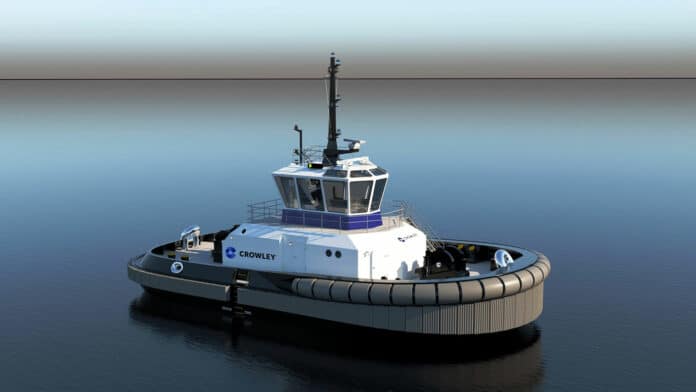Crowley’s eWolf, the first all-electric tugboat in the U.S., is undergoing sea trials along the U.S. Gulf Coast before officially entering commercial service, the company confirmed on social media.
The ship is being built by Master Boat Builders’ (MBB) shipyard in Coden, Alabama, and will be delivered in 2024. It will be used to assist ships arriving and departing at the Port of San Diego in California.
The innovative concept was first introduced by Crowley two years ago. The 82-foot (25-meter) eWolf is designed as a zero-emission vessel as it would operate fully electric. Equipped with a fully integrated electrical propulsion system by ABB, the system comprised two 2100 kW motors, a thruster, and a 6.2 MWh main battery. eWolf claimed to have the same performance as conventional tugboats, with 70 tons of bollard pull.
eWolf was created to replace old tugboats that consume over 30,000 gallons of diesel per year. According to the company, the electric tugboat can reduce up to 3,100 metric tons of CO2, 178 tons of nitrogen oxide, and 2.5 tons of diesel particulate matter in ten years without sacrificing performance. What’s more, the eWolf is equipped with the latest AI technology, including an “Intelligent Maneuver” feature and 360-degree visibility for maximum safety.
The eTug’s battery system enables the vessel to deliver one full day of normal work without using a drop of fuel. The batteries supply power to the propulsion system almost immediately, making it a reliable vessel for harbor escort services.
Additionally, the tug’s systems are designed to handle fast-changing load requirements. The vessel has two generators on board to provide emergency power and enable longer transit distances at a lower speed.
The tug will be based at the Port of San Diego’s Tenth Avenue Marine Terminal, where Crowley is building a dedicated charging station. The charging station will feature twin battery banks that will be charged by the solar panels during the day and the utility grid at night when the public demand for power is lower. When the tugboat pulls up to recharge, the batteries on the pier will transfer their accumulated power to the batteries on the tugboat.
This project was achieved with the collaboration of Crowley and other organizations, such as the San Diego County Air Pollution Control District, the California Air Resources Board, the Port of San Diego, the U.S. EPA, and the U.S. Maritime Administration.
